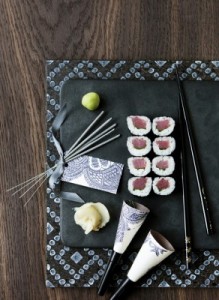 Yes, it is a sushi roll that is complex and hard to make because you have to think in whole.
Yes, it is a sushi roll that is complex and hard to make because you have to think in whole.
The filling for the sushi roll that should be a delicate. Beside that there is a filling on the outside that should give the sushi roll an additional dimension and depth. You must also be aware that the more raw materials you use in the preparation of the roll the harder it will also taste the individual ingredients.
Salmon is a nice and delicate fish so it do matter which ingredients are added to the fish otherwise you will create an imbalance in the taste experience.
Read more about Sushi chef & sake sommelier Zoë Escher
_
Zoë has held sushi courses and cooking classes for A. P. Moller – Maersk, Hugo Boss Nordic, Novo Nordisk, Novartis, Velux, Gorrissen Federspiel, Beierholm revision, Elbek & Vejrup and many more.








